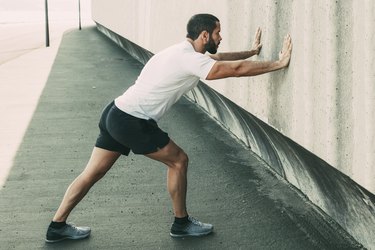
If you're a runner, tennis player, weekend soccer warrior, HIIT enthusiast, desk worker, pregnant person or someone who wears high heels, your calves can get tight and sore. And that can lead to pain or even injury.
"There is a link between tight calves and knee pain, ankle pain, lower back pain and neck pain," says Sarah Feilders, certified Pilates instructor and creator of the Extensa Method flexibility program.
Video of the Day
Video of the Day
Tight calves have also been associated with plantar fascitis, a heel injury that can linger for months. It can cause other serious injuries: "The Achilles can bear the brunt of it — you can tear it or pull it," says Heidi Kristoffer, yoga instructor and founder of CrossFlow Yoga. On the other end of the calf, tightness can cause injuries to the back of the knee.
But it's not just pain or injury, either. Calf tightness may cause you to lose range of motion so that your heels come up during certain movements, like squats. You use your calves with every step you take, every single day. So take care of them every day!
Try These 5 Stretches to Help Relieve Tight Calves
Treat those diamond-shaped muscles to some daily TLC when your muscles are warm — after a workout, at the end of a run or before bed with these stretches from Feilders, Kristoffer, and Tatiana Lampa, a certified personal trainer in New York, and founder of Training with T.
1. Downward Dog With Bent Knees
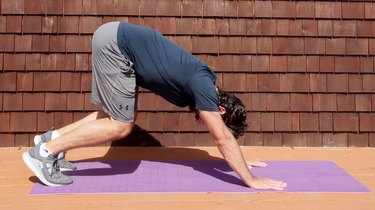
- Begin on all fours, with your knees directly beneath your hips and your hands directly beneath your shoulders.
- Tuck your toes under your feet and raise your knees slightly off the floor.
- Take your thighs to your belly and try to keep your thighs and belly connected as your raise your hips toward the ceiling. Keeping your thighs on or near your abdomen will help keep your knees bent.
- Unbend one knee, pushing the heel toward the floor, then switch sides.
- Continue pedaling your feet back and forth for 20 seconds.
Tip
In yoga, you stretch your calves every day, doing Downward Dog after Downward Dog, Kristoffer says. But if you’re not a veteran yogi, the full pose can be a bit of a shock to your calves.
“When you just jam both heels down, you don’t have anywhere to go, and you might really overstretch your calf. [Doing the pose with bent knees] is much more gentle. Using one leg at a time, you can focus on the calf that’s causing the problem.”
2. Seated Calf Stretch With Band
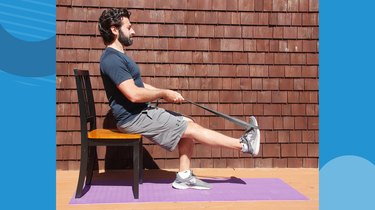
- Sit on the edge of a chair with your feet on the floor, knees bent 90 degrees. Wrap a resistance band or long belt around the ball of one foot so your leg is straight out in front of you.
- Flex your foot so that your toes come toward your torso, keeping tension on the band.
- Then point your toe, pressing against the resistance of the band.
- Repeat this sequence of pointing and flexing for 3 sets of 15 to 30 seconds on each leg.
Tip
This stretch can be done with both feet simultaneously, but Lampa suggests performing it with one leg at a time. That way, the resistance will be customized to the different tightness in each calf.
3. Standing and Seated Calf Raises

- Sit on the edge of a chair with your feet on the floor, knees bent 90 degrees.
- Press the balls of your feet into the floor and slowly raise your knees up. Squeeze slightly at the top.
- Lower to the floor under control.
- Repeat 20 times.
- Then stand tall with your feet shoulder-width apart, holding on to a chair or door jamb for balance.
- Press the balls of your feet into the floor, slowly rising up on your toes until your calves are flexed. Squeeze slightly at the top.
- Lower to the floor under control.
- Repeat 20 times.
Tip
To make sure you focus on moving through that full range, Feilders suggests doing the movement slowly — making sure you go all the way up, squeeze a little, then control the body the whole way down.
Performing the exercise while seated takes the gastrocnemius — the diamond-shaped part of the calf — out of the exercise, focusing the stretch on the soleus, the flat inner portion of the calf that’s closer to the ankle.
4. Supine Single-Leg Press
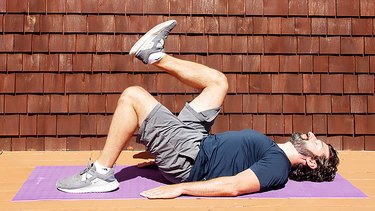
- Lie on your back with knees bent, feet flat on the floor.
- Lift one leg perpendicular to the floor (or as far as your flexibility allows), pointing your heel toward the ceiling.
- Perform a “squat” by bending your knee down toward your stomach. Continue to press your heel toward the ceiling.
- Straighten the leg back out.
- Perform 15 to 20 repetitions, then switch legs and repeat.
Tip
This exercise is like the leg press machine at your gym, but without the machine. To get the calf stretch, imagine you’re “standing on the ceiling,” and pushing your body down into the floor, says Feilders. In this way, your foot will be flexed as if you were planting it flat on the ceiling.
5. Standing Calf Stretch
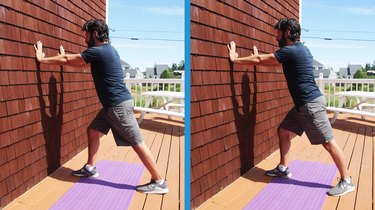
- Stand facing a wall with staggered feet, palms on the wall at shoulder height.
- Keeping the heel of your back leg planted, bend your front knee and slowly lean toward the wall.
- Now bend your back knee a bit. This will change the focus of the stretch to the soleus muscle. Then return to having your heel flat and knee straight.
- Continue this stretch for 60 seconds, changing the angle of your back foot from straight to slightly turned out to slightly turned in every 10 or so seconds. Then switch legs and repeat.
Tip
To get the most of this stretch, vary your foot and knee positions, says Feilders. “Change the foot position every 15 to 20 seconds — parallel, slightly turned out and slightly turned in,” she says.
By bending the back knee occasionally and transferring the weight slightly backward, you can change the focus of the stretch from the diamond-shaped gastrocnemius to the soleus muscle and back. “The entire stretch, including the different angles, should be approximately 60 seconds on each side.”